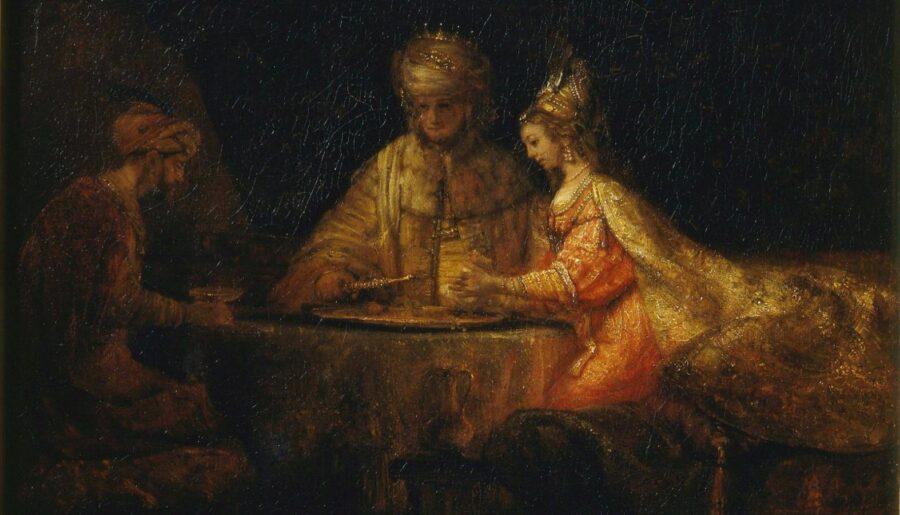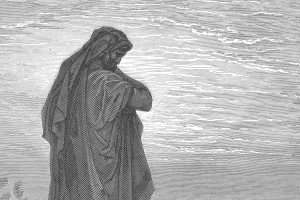[Update (2/14/2014)—My new book Esther and Her Elusive God: How A Secular Story Functions As Scripture is now available. My posts on this site represent stages in the development of my thinking about Esther. For the full argument check out the book].
Last week I wrote briefly about whether Esther belongs in the canon of Christian scripture. I concluded that it did, but my focus in this post is on how it fits. Perhaps the most distinctive feature of the Book of Esther is the lack of any reference to God. This is further accentuated by the fact that the story does not contain any key religious concepts from Judaism such as covenant, law, land, and election; as well as central religious customs such as dietary practices, sacrifice, prayer, and festivals. An important historical reason for this is that the story takes place in the Diaspora, that is, outside of the land of Israel. The Jewish people in the narrative of Esther are living in a foreign land among a foreign people. When Mordechai, Esther’s uncle, is introduced in the narrative we read that he was among those exiled from Jerusalem by Nebuchadnezzar (Esther 2.6). This point is quite important to keep in mind. The story is set up in a similar context as the story of Daniel. Additionally, not only is the historical context similar, but the Hebrew canon (the Tanakh) places the books of Daniel and Esther alongside each other. This appears to be intentional and the canonical shape calls for attention to be given to how the stories relate to each other. As an example of canonical intentionality, the Hebrew canon also places the book of Ruth directly after the book of Proverbs, which provides an interesting canonical relationship between the virtue of Ruth and the woman spoken of in Prov 31. So then, how do the stories of Esther and Daniel relate to each other? Allow me to postpone my answer to this question for the conclusion. The prior issue to determine is whether Esther is being presented as a reputable figure to be emulated or not.
Is Esther To Be Emulated?
As a whole, the people of God presented in Esther appear to be have forgotten their roots. In their foreign context, it appears that they had not maintained their status as a people set apart. Instead, they appear to have assimilated to the foreign culture. This relates directly to the lack of religious imagery in the book of Esther. As Ron Pierce concludes, “the author’s omission of any reference to Deity in Esther actually serves to highlight the secular nature of the people of God in the ancient Diaspora.”[1] Essentially, the Jews do not appear to be religiously distinct from their Persian neighbors in any way.
The question then is: is this also true for Esther? To put is simply, I believe the answer is yes. Let’s think specifically about how Esther got into the position she had in the first place. She entered an elaborate beauty contest and was able to ‘please’ the king more than her other female competitors (2.9, 17). The sexual nature of this contest is quite clear: “In the evening she would go in, and in the morning she would return to the second harem…” (Esther 2.14a ESV). It is also important to recall the contrast between Vasthi and Esther: the Gentile Queen is able to turn down the King (Esther 1.12), but Esther the Jew succumbs and wins the competition. By marrying the Gentile King this not only transgressed the Law (Deut 7.3-4), it was also completely aberrant from the social concerns of Ezra and Nehemiah (Ezra 9.1-2, 14; 10.2; Neh 10.31; 13.23-27). In fact, it is part of the reason the Jews were sent into exile in the first place! Additionally, there was no political pressure for Esther to join this competition because Haman’s evil plot isn’t introduced until Esther 3.1-6.[2] Likewise, Mordechai and Esther are determined not to tell anyone about their heritage as Jews before any political pressure is placed upon them (Esther 2.10, 20). This sneakiness is seen through the fact that Mordechai and Esther do not refer to their original Hebrew names (“Mordechai” is derived from the pagan god Marduk; Esther’s Hebrew name is Hadassah: 2.7).
Conclusion
Next week I will specifically address the aspects of the book of Esther where people have tried to demonstrate that there is a religious pulse among the people of God presented in the book of Esther. For this post my aim was simply to show areas of compromise. How this relates to the Christian canon is therefore immensely important. I believe that the story of Esther shows us that God remains faithful to his people even when they remain faithless. Clearly, God is an understood character behind the narrative. However, he is only present through the perspective of the narrator. The characters themselves do not acknowledge him but instead show clear signs of assimilation. This will be further demonstrated next week. But for now recall my comparison between Esther and Daniel. What we have juxtaposed in the Hebrew canon is two responses to living in Diaspora that could hardly be more polarized. Daniel purposes not to defile himself with the King’s meat (Dan 1.8), and Esther breaks all sorts of purity laws. Yet, it must be noted that the setting of the Book of Esther is not Exile! Cyrus the Great had already commissioned the Jews to return and rebuild Jerusalem. For some reason Mordecai has chosen to stay in Persia rather than return and join the efforts initiated by Ezra, Nehemiah, and Zerubbabel. Due to this sociopolitical setting, Jon Levenson has noted that the story does not include any vision of overthrowing foreign powers and that the main transformation of the story simply pertains to Anti-Semitism.[3] Thus, the main interest of the story is the hope of living with civility among the nations. This is exactly the kind of assimilation presented to us in the book of Esther.
[1] Ronald W. Pierce, “The Politics of Esther and Mordecai: Courage or Compromise,” Bulletin for Biblical Research 2 (1992): 77.
[2] Pierce, “The Politics of Esther and Mordecai,” 84. Even more, Esther’s marriage is to be contrasted with the marriage between Boaz as the Moabitess Ruth since Ruth converted to Judaism. See Pierce, “The Politics of Esther and Mordecai,” 76.
[3] Jon D. Levenson, Esther: A Commentary, OTL (Louisville, KY: Westminster John Knox, 1997), 15.





6 Comments
Leave your reply.